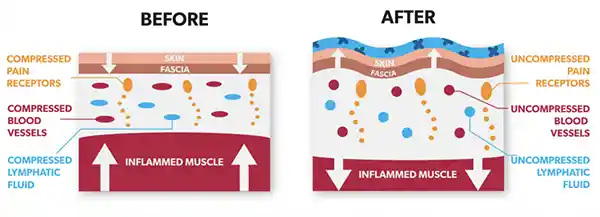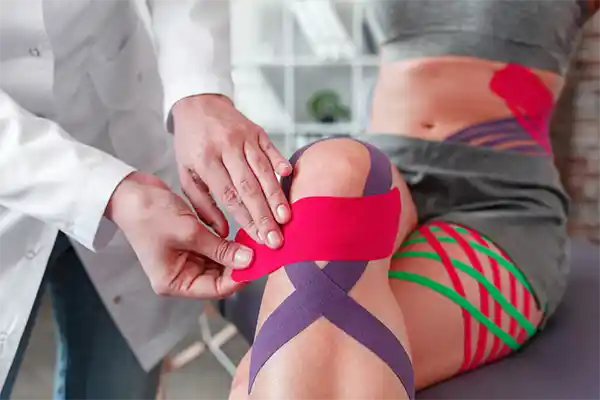Kinesiology Taping for Managing Plantar Fasciitis
Those who have experienced the unbearable agony of plantar fasciitis understand how it can bring about significant consequences that can hinder daily activities. This ailment stems from inflammation and discomfort in the plantar fascia, which is a tissue band that runs beneath your foot.
Thankfully, people dealing with it can explore several potential remedies for their condition. One such option that has grown in popularity lately is kinesiology taping.
Often referred to as K tape, it’s a stretchy, adhesive tape that is used to provide support, reduce pain, and promote healing in injured areas. Although primarily utilized by athletes, individuals grappling with plantar fasciitis who aren’t involved in sports could also find kinesiology tape advantageous.
So, how does it work for managing this issue?
How Kinesiology Taping Works

Kinesiology sports tape provides structural support to the affected area while allowing a range of motion. It replicates the elasticity of the skin and underlying muscles, promoting better blood and lymphatic fluid flow. It also helps reduce swelling, alleviate pain, and support weakened muscles and joints.
When applied correctly, it lifts the skin slightly, creating space between the skin and the underlying tissues. This space allows for improved blood circulation and lymphatic drainage, which aids in reducing inflammation and promoting healing.
The Dangers of Ignoring Plantar Fasciitis

It is evident that it can cause significant foot pain and discomfort. This condition is not to be taken lightly or underestimated in terms of its impact on everyday life activities.
As many know, it’s caused by strain or inflammation on the thick band of tissue attaching our heels to our toes resulting in sharp pain in both areas affected. While some may shrug off this affliction as just another minor inconvenience, doing so could put their overall foot health at risk if they delay seeking treatment immediately.
Early intervention is key to avoid serious consequences from developing with regards to it. Here’s why early treatment is essential and the dangers of not addressing the issue promptly:
Chronic Pain and Discomfort
Persistent pain and ongoing discomfort may arise from unresolved cases. The pain may start off as a mild annoyance but can gradually worsen over time, making simple activities like walking or standing unbearable.
Refraining from acknowledging physical discomfort can negatively impact various aspects of everyday living, including reduced satisfaction with life and limited involvement in leisurely pursuits.
Impact on Mobility
It can significantly affect your mobility. Doing simple things like walking or running without discomfort becomes a daunting task when there is swelling and pain involved.
As a result of these inflammation issues, some physical activities, including sports, may be almost impossible to engage in effectively.
Compensation Injuries
Foot pain is a common issue that prompts many people to modify their gait without realizing it.
However well-intentioned this response may be, changing one’s biomechanics like this can ultimately cause more harm than good by creating additional overuse injuries elsewhere in the body – particularly in areas like the hips, lower back, or knees. These compensatory injuries can further exacerbate pain and limit your ability to perform daily activities.
Development of Heel Spurs
In some circumstances, if left untreated, it can lead to the formation of heel spurs. Heel spurs are bony protrusions on the heel bone caused by prolonged inflammation and stress.
As a result, treating it can be more difficult.
Prolonged Recovery Time
A delay in treatment can lead to prolonging your recovery time. The condition results in inflaming and inflammation might persist and develop into a more severe issue if not addressed properly.
Increased Treatment Complexity
Early intervention is key to its successful management. When treated promptly, conservative measures such as stretching exercises, physical therapy, orthotics, and taping can often alleviate symptoms and promote healing.
Should plantar fasciitis persist without proper treatment over time it could escalate in severity and call for more assertive courses of action including the administration of corticosteroid injections or potentially invasive surgeries.
Benefits of Kinesiology Taping for Plantar Fasciitis

Pain Relief
One of the main benefits of this practice is pain relief. The tape aids in relieving the unpleasant sensations linked to plantar fasciitis by helping it and redistributing the applied pressure.
It also reduces inflammation to make for a faster healing process.
Improved Circulation
The application of kinesiology tape increases blood circulation and lymphatic fluid flow in the affected area. This enhanced circulation helps deliver nutrients and oxygen to the tissues and removes waste products, promoting healing and reducing swelling.
Enhanced Support
It provides additional support to the weakened or overstretched. Offering support and stability helps reduce strain on the injured tissue, allowing it to heal more effectively.
Increased Mobility
Unlike traditional athletic tape, which restricts movement, and allows a full range of motion.
This is particularly beneficial for individuals, as it enables them to continue with their daily activities and even participate in light exercises or sports while wearing the tape.
Application Techniques

Applying tape requires proper technique to ensure maximum effectiveness. Here’s a comprehensive walkthrough on the appropriate technique for using it to alleviate the symptoms:
- Start with clean, dry skin. It’s important to remove any dirt, oils, or lotions from the affected area to ensure proper adhesion.
- Trim a portion that is adequate in size to go over every part of your foot, ranging from where it touches the ground at the heel up until it reaches each individual toe.
- Round the edges of the tape to prevent premature peeling.
- Apply the tape effectively by placing it with no pressure, just behind the base of your toes in the middle section of your foot.
- Gradually apply tension to the tape as you anchor it along the foot’s arch, finishing at the heel.
- Rub the tape gently to make sure it sticks properly.
- Repeat the process if necessary, using additional strips of tape to provide more support if needed.
Remember that taping alone is not the cure. When combined with additional therapies such as stretching exercises, orthotics, and physical therapy, its effectiveness skyrockets.
Before attempting taping, always speak with a specialist or physical therapist to ensure proper application and integration with your complete treatment plan.
Where to Find Quality Kinesiology Tape
When purchasing kinesiology tape, it’s crucial to pick a reliable brand that delivers high-quality products. One such brand is Hampton Adams, which specializes in sports tapes and other sports medicine products.
Hampton Adams offers a wide range of options in various colors and formats, including precut strips and uncut rolls. Industry experts appreciate their products’ long-lasting nature, strong adhesion, and comfortable design.
Takeaway
Kinesiology taping is a versatile and effective technique for managing plantar fasciitis. Its ability to provide support, reduce pain, and promote healing can significantly contribute to your recovery and overall foot health.
Combining kinesiology taping with other treatments, such as stretching exercises, orthotics, and physical therapy, can maximize the benefits and expedite your journey toward pain-free mobility. You deserve to live an active lifestyle without being held back by foot pain. Don’t wait any longer to seek help, and your feet will thank you for it!








